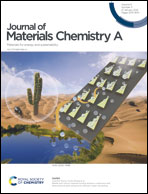Structurally and chemically engineered graphene for capacitive deionization
Abstract
Highly efficient capacitive deionization (CDI) relies on unimpeded transport of salt ions to the electrode surface. Graphene is an ideal candidate to provide superb conditions for ion adsorption as it possesses high theoretical surface area and electrical conductivity. When ions are stored solely within the electric double layers (EDLs), a hydrophilic graphene surface with hierarchical pores can maximize the accessible surface area and promote the ion transport. In the case of synergistic ion storage via electrostatic adsorption and faradaic redox reaction, graphene can act as both the electron highway and the reciprocal spacer to provide surface-confined effects. Substantially, structural and chemical engineering towards graphene can enhance the ion removal capacity and rate, and improve the charge efficiency and ion selectivity. In this review, we keep pace with the in-depth studies of CDI technologies and recent progress on graphene-based materials for CDI. Major challenges in the rational assembly of the desired material functionalities in terms of surface area, pore structure, and hydrophilicity are addressed. As electrode materials develop, the ultimate goal is to achieve highly efficient, energy-saving, and environment-friendly CDI.



 Please wait while we load your content...
Please wait while we load your content...